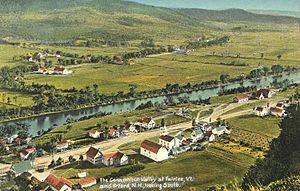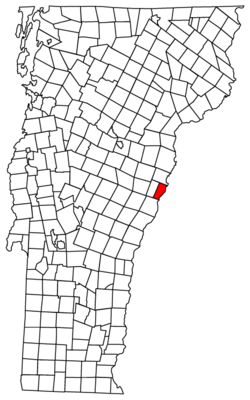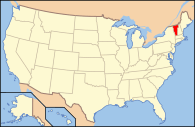Fairlee, Vermont facts for kids
Quick facts for kids
Fairlee, Vermont
|
|
|---|---|
|
Town
|
|

Fairlee from Morey Mountain c. 1907
|
|

Located in Orange County, Vermont
|
|

Location of Vermont with the US
|
|
| Country | United States |
| State | Vermont |
| County | Orange |
| Chartered | 1761 |
| Area | |
| • Total | 21.2 sq mi (55.0 km2) |
| • Land | 20.2 sq mi (52.3 km2) |
| • Water | 1.0 sq mi (2.7 km2) |
| Elevation | 440 ft (130 m) |
| Population
(2020)
|
|
| • Total | 988 |
| • Density | 49/sq mi (18.9/km2) |
| • Households | 471 |
| • Families | 250 |
| Time zone | UTC-5 (EST) |
| • Summer (DST) | UTC-4 (EDT) |
| ZIP Codes |
05045 (Fairlee)
05033 (Bradford) |
| Area code(s) | 802 |
| FIPS code | 50-25675 |
| GNIS feature ID | 1457398 |
| Website | www.fairleevt.org |
Fairlee is a small town in Orange County, Vermont, USA. In 2020, about 988 people lived there. The village of Ely is also part of Fairlee. Fairlee is famous for Lake Morey, which has the longest ice skating trail in the United States!
Contents
History of Fairlee
Fairlee was first given its official charter on September 9, 1761. This happened thanks to Governor Benning Wentworth. He gave the land to Josiah Channey, Joseph Hubbard, and 62 other people. The first settlers arrived in 1766.
In 1797, the western part of Fairlee became its own town, called West Fairlee. By 1859, Fairlee had 575 residents. It was a busy place with several sawmills, a gristmill (for grinding grain), and a factory that made lead pipes and pumps.
Fairlee Railroad Depot
The Fairlee Railroad Depot was built in 1848. It was constructed by the Connecticut & Passumpsic Rivers Railroad. This depot is very old and important. It is the oldest train station building still standing along the Connecticut River. In 1998, it was added to the National Register of Historic Places.
Geography and Nature
Fairlee covers about 21.2 square miles (55 square kilometers). Most of this area is land, about 20.2 square miles (52.3 square kilometers). The rest, about 1 square mile (2.7 square kilometers), is water.
The town is next to the Connecticut River. Several streams flow through Fairlee, including Glen Falls Brook and Big Brook. Water also flows out of Lake Morey. The main part of Fairlee village is on the eastern side of the town, along U.S. Route 5.
Population and People
| Historical population | |||
|---|---|---|---|
| Census | Pop. | %± | |
| 1790 | 463 | — | |
| 1800 | 386 | −16.6% | |
| 1810 | 983 | 154.7% | |
| 1820 | 1,143 | 16.3% | |
| 1830 | 656 | −42.6% | |
| 1840 | 644 | −1.8% | |
| 1850 | 575 | −10.7% | |
| 1860 | 549 | −4.5% | |
| 1870 | 416 | −24.2% | |
| 1880 | 469 | 12.7% | |
| 1890 | 398 | −15.1% | |
| 1900 | 438 | 10.1% | |
| 1910 | 438 | 0.0% | |
| 1920 | 459 | 4.8% | |
| 1930 | 456 | −0.7% | |
| 1940 | 535 | 17.3% | |
| 1950 | 571 | 6.7% | |
| 1960 | 569 | −0.4% | |
| 1970 | 604 | 6.2% | |
| 1980 | 770 | 27.5% | |
| 1990 | 883 | 14.7% | |
| 2000 | 967 | 9.5% | |
| 2010 | 977 | 1.0% | |
| 2020 | 988 | 1.1% | |
| U.S. Decennial Census | |||
In 2000, there were 967 people living in Fairlee. There were 395 households, which means 395 homes where people lived. About 265 of these were families. The average household had about 2.42 people.
The population was spread out by age. About 23.6% of the people were under 18 years old. About 15.4% were 65 years or older. The average age in Fairlee was 41 years old.
Town Infrastructure
Transportation Routes
Fairlee has several important roads that run through it. These include ![]() Interstate 91, which is a major highway. Also,
Interstate 91, which is a major highway. Also, ![]() U.S. Route 5 and
U.S. Route 5 and ![]() Vermont Route 244 pass through the town.
Vermont Route 244 pass through the town.
Education in Fairlee
Students in Fairlee are part of the Rivendell Interstate School District. The local elementary school is Samuel Morey Elementary School. In 2023, the school board decided to close this school.
Notable People from Fairlee
Many interesting people have connections to Fairlee:
- Helen Gahagan Douglas was an actress and a US congresswoman.
- Milton Friedman was a famous economist. He used to spend his summers in West Fairlee.
- William H. Gilmore was the Adjutant General of the Vermont National Guard.
- Richard W. Mallary served as a US congressman.
- Samuel Morey was an inventor.
- George W. Morrison was also a US congressman.
- Nathaniel Niles was a politician.
- Stephen Thomas was a politician and a brigadier general in the army.
See also
 In Spanish: Fairlee (Vermont) para niños
In Spanish: Fairlee (Vermont) para niños

